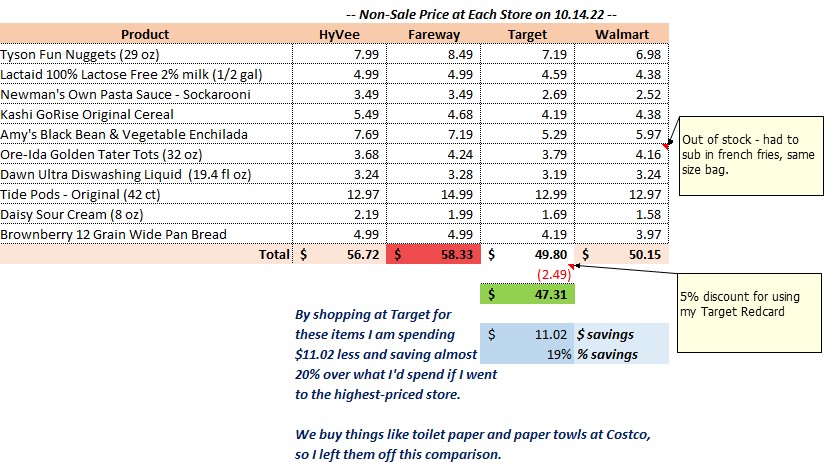Is Comparison Shopping Worth It?
Life can be hectic – especially so in certain seasons (i.e., raising small children, working long hours, caring for others). Your local supermarket is super convenient. Is it really worth it to spend time comparing prices with other stores? (Spoiler – the answer is yes!)
Having worked as an accountant my entire adult life you’d think I’d have been on board with this from day one. I love analysis. (Excel is my BFF!) But for some reason, digging into prices at the various stores in my area didn’t seem like a valuable use of my time. We were creatures of habit – generally hitting the large supermarket near our house on a Sunday afternoon for the main shopping run (along with 50% of the residents of our city, I’m pretty sure) and then stopping several more times during the week to pick up all the stuff we forgot the first time.
The pandemic was an eye-opener for me. Because I have heart rhythm issues and because, well, we don’t particularly enjoy being ill – especially with something that might kill us – we opted to stay close to home until we were fully vaccinated in the spring of 2021. Both my husband and I were working from home and our son was virtual schooling. No way were we going to set foot in a grocery store or any store for that matter if we didn’t have to. And for a year, we simply didn’t.
Shout out to “curb pickup”
If there’s one good thing that has come out of the pandemic, it’s curb pickup. Some stores had already dipped their toes in the water prior to 2020. Everyone was forced to pivot that direction or step up their game once things started shutting down. And let me tell you, even without comparison shopping we saved money by just driving up and having our pre-ordered groceries stuffed in the trunk of our car. Impulse purchases dropped to near zero!

Of course, pre-ordering these groceries required me to spend time shopping online. I am adept at online shopping and use it frequently (Jeff Bezos should thank me for all I’ve done to support his business), but shopping for groceries online was a new thing for me. At first, I went straight to the default – ordering from the large local supermarket. Then one day I must have been bored because I decided to compare my shopping list to what I’d pay for the same items if I ordered them from Target. I was shocked at what I found!
I remember comparing a bag of Gorton’s fish fillets and finding that they were over $7 at the supermarket vs. something like $5.29 at Target. That’s a 25% savings. Not everything reflected that same deep discount and some items were actually more expensive at Target. Still, combined with my Target RedCard which got me 5% off all purchases, it made sense for me to do most of my shopping for brand name items at Target using curb pickup at that time.
Several months into the pandemic, our other local grocery store began offering online ordering and curb pickup so I tossed them into the mix. I don’t always comparison shop with Walmart because of the four biggies near me they’re the furthest away, but if I’m going to be in the area I’ll sometimes look at what they have as well.
How much will comparison shopping save me?
Truth: I don’t know. You’ll have to do the comparison for yourself using your local retailers. But as an example, here are prices from four major stores in the Des Moines metro area as of mid-October 2022 for items we frequently purchase. I tried to select products that aren’t currently on sale so as to compare apples to apples (haha! apples! grocery shopping!).

And here’s the thing – once I had my list of items ready, it took me five minutes at most to pull up the stores’ online shopping websites and grab the current prices. In this scenario I could save nearly 20% by doing my shopping at Target. Even if you are only able to reduce your total bill by 10%, multiply that times all your grocery purchases during the year and you can save a chunk of change! This could be a potential cost savings for you to plug into your monthly budget.
Things to consider
There are a lot of ways to slice and dice this. I’ll try and hit the high points:
- Target – if I want to save money here, I really must stick with curb pickup! Target’s marketing and design folks are some especially talented individuals. I walk into the store with a purpose in mind and the minute I’m through the second set of sliding doors, I look to the left and see…oh, the pretty candles and housewares…and things just get so much more complicated. I can go in with a list of five food items, find that three of them are out of stock (because I didn’t check online before I went shopping), and end up walking out with a new lighted ceramic pumpkin and pullover hoodie. For real!

- Don’t spend time comparing prices on every little item every time. If you’re going in for a bunch of green onions, their price won’t differ much across any of the stores. Same goes for those small Tone’s spice containers. You get the idea. Sure, if you have 100 items and they’re all $1.00, the differences could add up. But generally if the bigger stuff is cheaper in one store, the little stuff is likely not more expensive.
- Don’t forget to check for sales. Both local grocers I shop at post their weekly sale ads online. The first thing I do is look those over as I’m making my list. Meal plan at the same time if you can. This way you can be sure you’re only buying what you need. Also, by basing your meals around the sale items you’re saving even more money. It may change the store you end up going to.
- Shop at more than one store. True, this can be time-consuming. For us, HyVee and Fareway are one mile apart so I sometimes do a quick loop to hit both. This allows me to score the best prices at each place.
- Consider distance! You might have noticed gas is expensive lately. We live within two miles of both supermarkets and within five miles of Target and Walmart. If your grocer is local but you are 25 miles from Walmart and you drive a gas-guzzler, your savings are going to be reduced rapidly!
- There are some items that are non-negotiable for us:
- Fresh produce almost always comes from Hy-Vee. Because they’re a more upscale supermarket and they get a ton of business, I find that their produce selection is generally larger and of better quality than that from the other stores. Sure, bagged carrots or lettuce or even boxed berries are fairly similar everywhere. But the quality of the loose produce does differ a lot between the locations.
- Fareway is our go-to for meat. Their produce is ho-hum but they have quality meat with competitive prices. An added bonus is their butcher counter so you can select exactly what you want. The quality is also very good. I have more recently started to be a few meats in bulk at Costco, but most still comes from here.
- If you are a member of Costco or Sam’s Club, definitely compare prices there as well. We purchase most household goods we use in bulk (i.e., detergent, paper towels, toilet paper, pizza’s) at Costco. Generally they are the cheapest, but sometimes Target or another store will be having a sale or a free gift card promo that beats the Costco prices. Don’t just assume.
- Aldi – we have one close to the house and I’ve been there a few times. Prices are lower, but it’s difficult to compare because most of what they sell is their proprietary store brand. They don’t really mark their few brand-name items down. Also, while there are things I like from Aldi, I’ve picked up products that were less-than-stellar as well. Or, like the ketchup we were buying from there because it tastes similar to Heinz, I noticed when reading the ingredients recently that it’s made with high fructose corn syrup rather than the sugar Heinz uses. Splitting hairs maybe (neither ingredient will win a health award), but we use a lot of ketchup. I feel like some of the cost savings comes through quality compromise and I tend to be more of a “quality over quantity” person.
See – it sounded like a lot of work in the beginning but it’s really easy, common-sense stuff! Go be empowered to save some money!









